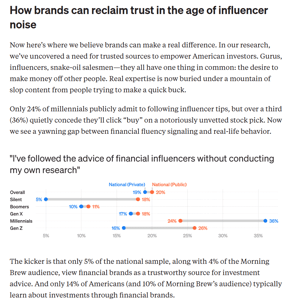
Discover the product features that customers actually value
Reveal which features really matter
We are constantly making choices, some conscious, but most unconscious. Standard methods that expect consumers to know what they really want miss the hidden motivators that drive preference. Most standard methods don’t simulate real-life conditions, which always include some type of situational trade-offs. Therefore, it's best to use trade-off experiments to simulate realistic consumer decision making.
The Gradient difference
- Define the decision
Before we even think about data and models, the first thing we put on paper are the decisions you need to make. Whether you’re launching a new product, rebranding an existing line, or testing a tiered subscription model, we develop a bespoke analytical plan data that zeroes in on your specific decisions. - Design targeted research
We use advanced statistical tools, but we always remember the human side of research. We tailor surveys and experiments to extract only the insights critical to your decision, nothing more, nothing less. - Analyze & interpret
Our team of data scientists and social researchers interrogate the numbers. Beyond just the “what,” we pinpoint the “why”, uncovering the hidden preferences, allowing you to build the product consumers really want. - Activate insights
Finally, instead of broad reports, we provide clear recommendations to guide your product roadmap.

Survey methodologies that drive results
Conjoint analysis is a technique for quantifying how the attributes of products and services affect preference. It is typically used to help identify the optimal design of products, messaging, and pricing.
A conjoint compares combinations of attributes. Each consumer is shown multiple lists with varying combinations of the attributes.
Across multiple lists of choices from hundreds of respondents, a statistical model identifies precisely how much each attribute and level contributes to making the decision.
-
Identify the optimal combination of product attributes.
-
Simulate realistic shopping experiences.
-
Understand how market changes affect consumer behavior.
A Max(imum) Diff(erences) analysis assesses conumers’ preferences without directly asking them. Instead of ranking a long list of features which can be cumbersome and cognitively taxing, a MaxDiff has consumers choose the “best” and “worst” options out of a given set over multiple different combinations.
-
Simulate real-life trade-offs to uncover real preferences.
-
Identify which features have the highest impact on customer perceptions.
Kano Analysis categorizes product features based on their effect on customer satisfaction, distinguishing between basic requirements, performance features, and delightful extras:
-
Differentiate between what is expected and what can truly delight your customers.
-
Focus on features that transform customer experience and drive loyalty.
Success stories at a glance

How Gradient uncovered the mindsets and preferences of Reformation’s customer segments, along with identifying their total addressable market.
Read more
A quantitative investigation of Americans’ mindsets toward personal finance and investing
Read more

Trusted by leading organizations
























